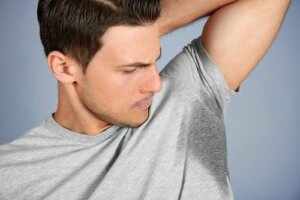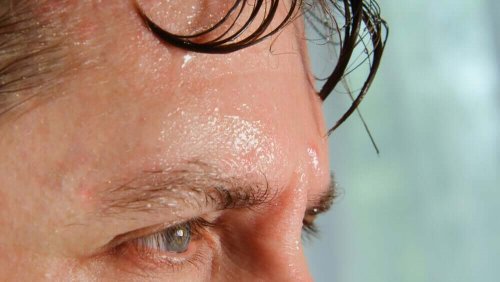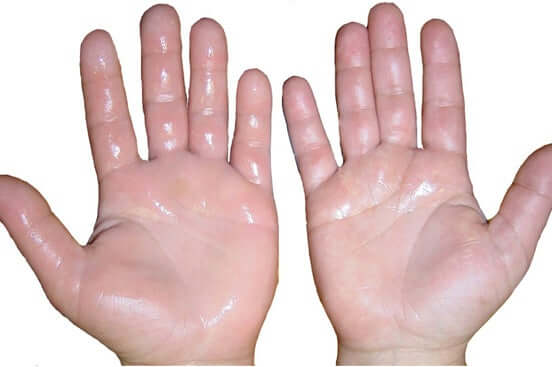Hyperhidrosis Sweating: Causes and Symptoms


Written and verified by the doctor Leonardo Biolatto
Hyperhidrosis sweating is when the human body sweats abnormally. It’s excessive sweating that doesn’t have a triggering cause.
It’s natural to expect increased sweating on extremely hot days or during physical activity. However, in hyperhidrosis, these situations don’t trigger excessive sweating, it’s just constantly there.
Sweat is basically water. Only 1% of its components are salts. The sweat glands produce it in the body to regulate body temperature. It’s the nervous system that orders, in normal situations, to sweat more or less.
Even if it’s the whole skin that sweats, the disorder is more evident in the hands, feet and armpits. If the moisture is stored in these regions for a long time, they can become infected generating odor by the decomposition of sweat through bacteria. This situation is called bromhidrosis.
Specialists estimate that 2 % of the world’s population fulfill the criteria of hyperhidrosis. In addition, it’s common for the disorder to run in families as parents and children, or siblings tend to have the same condition.
Causes of hyperhidrosis sweating
Basically, we can attribute hyperhidrosis to two general causes: primary or idiopathic, and secondary. The most common form of presentation is primary hyperhidrosis, in other words hyperhidrosis that’s self-generated.
On the one hand, the primary type is called essential focal hyperhidrosis. The problem lies in the nerves that innervate the sweat glands. In these people, these nerves are overactive, stimulating the production of sweat all the time. Although this type of sweating doesn’t have anything to do with heat or exercise, it can increase with stress.
On the other hand, secondary causes of hyperhidrosis are varied. These are diseases that have among their symptoms increased sweating. Among them we have:
- Hyperthyroidism and hypothyroidism: Thyroid hormones, as regulators of metabolism, can affect sweat production.
- Diabetes: In some people, excessive sweating in the chest area raises suspicions about the possibility of having diabetes.
- Coronary ischemic disease: In acute cardiac episodes, the stimulus that pain generates on the sympathetic nervous system can trigger profuse sweating.
- Systemic infectious conditions: Partly due to fever and partly due to the acceleration of metabolism during an infection, the acute episode is often accompanied by hyperhidrosis.
- Neuropathies: Specifically, diseases of the peripheral nerves and the sympathetic nervous system can alter the innervation of the sweat glands.

Keep reading: 6 Medical Causes of Night Sweats
Diagnostic criteria and symptoms
Any sweating that’s perceived as excessive can’t automatically be diagnosed as hyperhidrosis. The medical community has established criteria that, if fulfilled, allow the pathology to be diagnosed.
The first unavoidable condition is that the patient must have suffered more than six months of excessive sweating without a direct explanation. That’s to say, sweating generated without suffering from heat episodes or after intense exercise.
In addition to this characteristic, doctors look for at least two of the following circumstances:
- Impairment of daily activities.
- The appearance of excessive sweating at least once a week.
- Having suffered from it since before the age of twenty-five.
- Having a family member with hyperhidrosis.
- Sweating symmetrically: in both armpits, for example, at the same time.
- Sweating during sleeping hours on nights that aren’t particularly hot.

Keep discovering: All About Anhidrosis: The Inability to Sweat Normally
Treatments for hyperhidrosis
- Antiperspirants: This is often the first measure that those suffering from hyperhidrosis take. In general, it’s usually a self-initiated treatment before consulting a doctor. The most effective component of antiperspirants is aluminum chloride. The adverse effects are skin irritation, especially in people with sensitive skin.
- Medicine: Although there are drugs to reduce sweating, doctors don’t always prescribe them due to their adverse effects.
- Iontophoresis: The basis of this technique is electricity. It annuls the function of the sweat glands through electric currents. The treatment requires a series of sessions to be effective and has no major adverse effects. In conclusion, it controls the passage of current and in no way reaches dangerous levels for the body.
- Botulinum toxin: Specialists directly inject the substance into the area most affected by hyperhidrosis to block the nerves that carry the sweating stimulus. In addition, doctors can inject it into the armpits, hands, and feet.
- Surgery: The surgical procedure par excellence for those who require it is endoscopic thoracic sympathectomy. It’s reserved for cases of maximum severity where the quality of life worsens or dermal infections are very frequent due to the humidity generated. The procedure consists of cutting a nerve of the sympathetic nervous system to stop the stimulation of the sweat glands.
All cited sources were thoroughly reviewed by our team to ensure their quality, reliability, currency, and validity. The bibliography of this article was considered reliable and of academic or scientific accuracy.
- Pérez, Marco Antonio Callejas, et al. “Hiperhidrosis primaria.” Medicina Clínica 119.17 (2002): 659-665.
- Hernández Gutiérrez, José Manuel, Gustavo Salinas Sedo, and Josefina Nodal Ortega. “Hiperhidrosis esencial, recomendaciones para su tratamiento.” Revista Cubana de Cirugía 50.4 (2011): 597-601.
- Hoorens I, Ongenae K. Primary focal Hyperhidrosis: current treatment options and a step-by-step approach. J Eur Acad Dermatol Venerealol 2012; 26: 1-8.
This text is provided for informational purposes only and does not replace consultation with a professional. If in doubt, consult your specialist.








